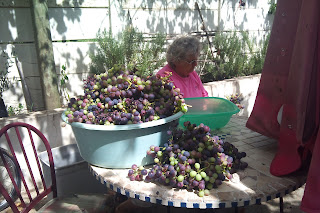Please read this article below from an excellent paint chemist who produces real natural paint as he explains how a big paint manufacturer is lying to the public.
In my mind, when you buy a processed item of food which is labelled "organic"- like jam, you expect the ingredients to be grown organically. How is it any different in paint?
| Organic Paints – |
ProNature feels very much
obliged to respond to the sudden occurrence of so called “organic”
and “natural” paints in the market place.
When calling something
organic or natural the general public expects to receive materials
which are derived from a non-toxic, sustainable and eco-friendly
managed source. This source must be managed by organic or at least
bio-dynamic principles which do refrain from the use of synthetic
pesticides, fertilisers or additives and which are not genetically
modified. The definition “organic” is hence predominantly used
when talking about foodstuffs.
So ProNature finds it
very peculiar that a prominent South African paint company managed to
evolve a paint system which is advertised amongst other things (lead
free, solvent free, zero VOC) to be of organic and natural origin.
When enquiring with the technical directorate of this paint company
we were very surprised to be introduced to a new definition of
organic and natural.
To our enquiry the
company responded as follows:
- We define the organic content of our paint based on the natural content of raw materials (i.e. classification of % natural (= non petrochemical) of each raw materials).Examples are water, as well as carbonates, etc, etc that are extracted from natural stone/earth.
- For example: if a paint is made out 50%wt of water, 20%wt polymer (at 50% natural content) and 10% calcium carbonate; then the organic content is 70% of natural content.
- The other proposition ,i.e. 30%, is not harmful (e.g. it is APEO free, Lead free, zero VOC, solvent free, waterbased dispersions),but we do not classify it as organic.
Let’s try to understand
what is actually said here:
….despite the fact that
non-environmentally concerned chemists would argue that in principle
nothing is wrong with above definition.
1. Chemistry, and this
includes paint chemistry, can broadly be divided into two groups:
Organics (see definition No.7) and Inorganics. Instead of reinventing
a definition for these terms we took the liberty of using some online
excerpts defining organic and inorganic chemistry:
Organic
chemistry is
a chemistry subdiscipline
involving the scientific study
of the structure, properties, and reactions of organic
compounds and organic
materials,
i.e., matter in its various forms that contain carbon atoms.
The
objects of study in organic chemistry include hydrocarbons,
compounds containing only carbon and hydrogen,
as well as compositions based on carbon but containing other
elements.
Organic
chemistry overlaps with many areas including medicinal
chemistry,
biochemistry, organometallic
chemistry,
and polymer
chemistry,
as well as many aspects of materials
science.
Organic
compounds form
the basis of all earthly
life.
They are structurally diverse. The range of application of organic
compounds is enormous. They either form the basis of, or are
important constituents of, many products including plastics, drugs,
petrochemicals, food, explosive
material,
and paints.
Inorganic
chemistry is
the study of the synthesis and behavior of inorganic and
organometallic compounds. This field covers all chemical
compounds except
the myriad organic
compounds (carbon
based compounds, usually containing C-H bonds), which are the
subjects of organic
chemistry.
The distinction between the two disciplines is far from absolute, and
there is much overlap, most importantly in the sub-discipline
of organo-metallic
chemistry.
It has applications in every aspect of the chemical
industry–including catalysis, materials science, pigments,
surfactants, coatings, medicine, fuel, and agriculture
2. If one were to
classify paints on above definitions virtually all paints could be
called organic even those that are solvent based and full of organic
toxins.
3. Since a great number
of paint raw materials are derived from naturally occurring resources
(which could be carbonates, iron oxide pigments, water and crude oil)
it would be very easy to achieve a 70% natural content. What this
definition does not reveal is how wasteful, energy intensive and
unsustainable it is to derive some of these raw materials in a
useable form.
4. When looking further
at the examples given by the paint manufacturer we do come to realize
that a portion of this paint recipe is based on fossil fuels or
rather petro chemicals, a raw materials source which is clearly not
sustainable.
5. As CEPE (The voice of
paint, printing ink and artist’s colour in Europe) states in their
“Guidance on Self-Declared Environmental Product Claims”:
“An environmental
claim like “does not contain substance X” for a particular DIY
decorative paint does not reflect any benefit to the environment when
this substance X is forbidden and the ‘non-containing’ is just a
matter of compliance with the law. In that case the claim would not
be meaningful and could even be misleading to consumers, making them
believe that other paints do contain substance X.”
We are aware that such
guidance for the South African paint industry is not in existence but
nevertheless feel very much the same about the subject. A lack of
such guidance should, however, not allow manufacturers in South
Africa to take the mickey out of their clients.
In
conclusion ProNature believes that calling a paint 70% organic and
natural just because it contains 50% water and some carbonates is
really taking the concerned client for a fool feeding them with
inappropriate and misleading information.
Such
companies should at least make an effort declaring their ingredients
so that clients can judge for themselves if a product is Organic and
Natural.





